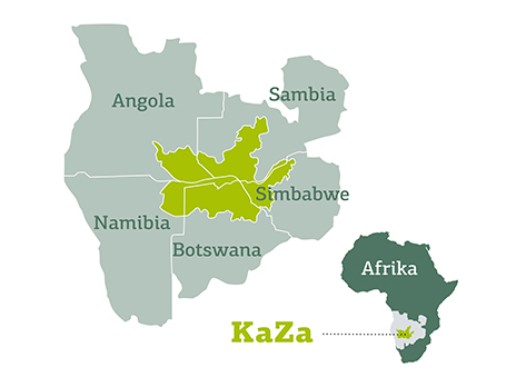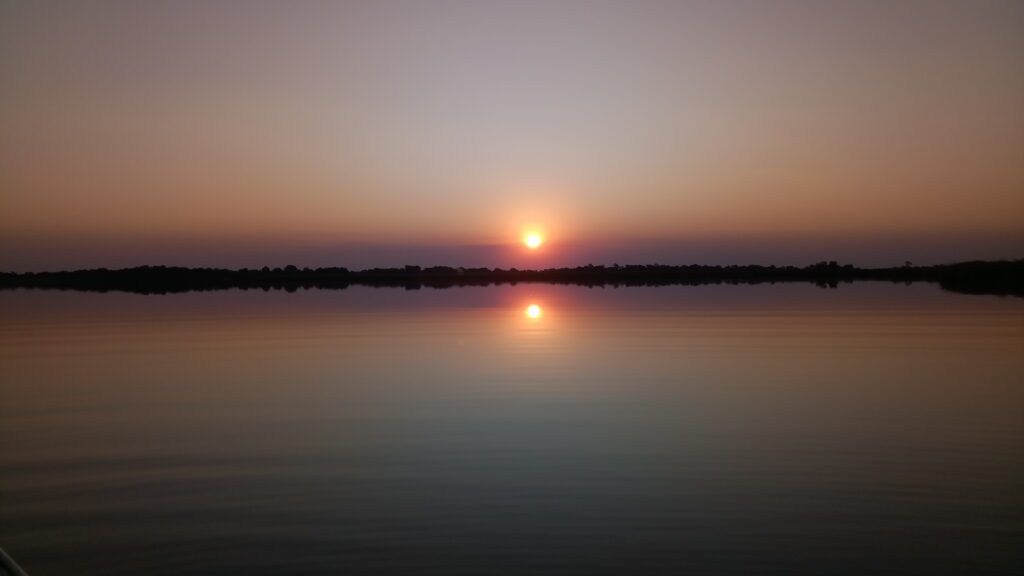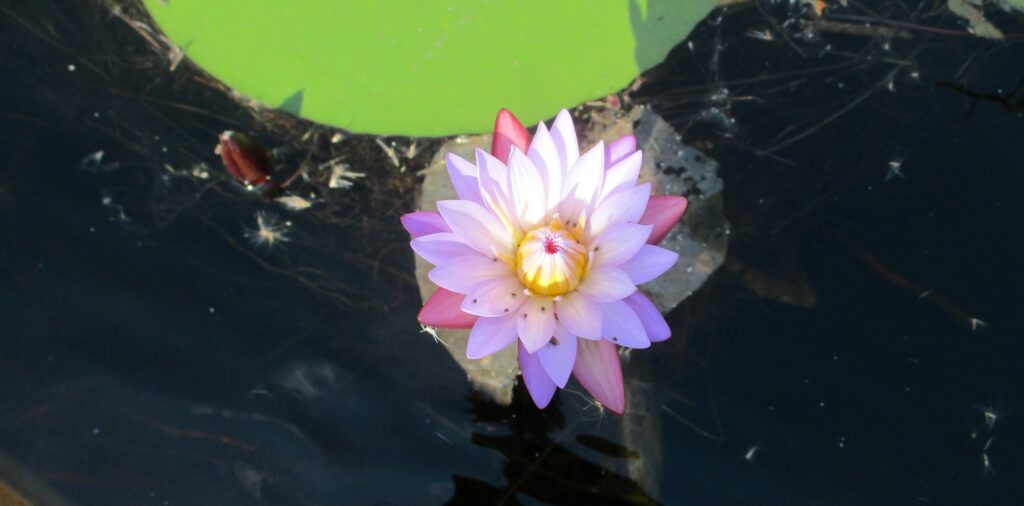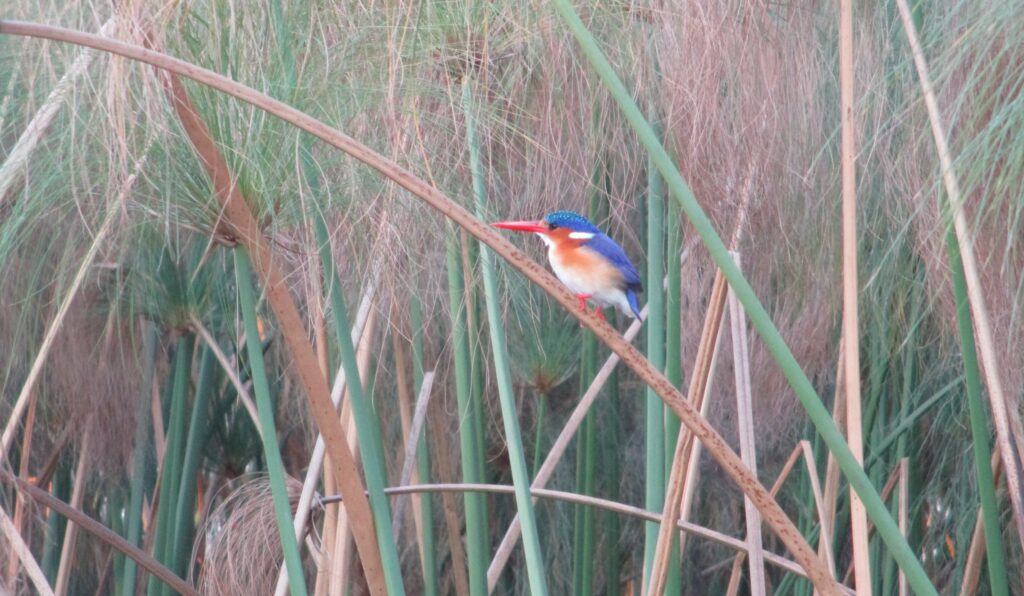The world is at crossroads. Global warming and biodiversity loss is increasing by the hour. Wars are raging while the planet is burning. There’s no way to deny the obvious. Or the looming doom at the horizon. It’s easy to lose hope. It’s hard to find the needed daily energy to fight for a better world. But hope is not dead and there are positive developments which show that not everything is lost yet and that the fight is worth fighting. Andy Gheorghiu outlines in this blog his vision for a fossil free KAZA region in sub-Saharan Africa and explains why it could develop into a global lighthouse project for a better world.

Kavango-Zambezi Transfrontier Conservation Area. Credits: KfW, All Rights Reserved.
KAZA and oil/gas extraction plans
The Kavango Zambezi Transfortier Conservation Area (KAZA), is a rare place on Earth. It is the world’s largest trans-boundary conservation area, extending over 520,000 km2 – the size of France and the UK combined – and covering five countries, Angola, Botswana, Namibia, Zambia and Zimbabwe. It also serves as a peace park of formerly conflicting countries. Its main sponsor is the German state-owned bank KfW.
A planned fossil fuel extraction project in KAZA is threatening a unique ecosystem, the UNESCO World Heritage site Okavango Delta as well as the livelihood of indigenous people living in the area. ReconAfrica, a Canadian company, was granted licenses by the governments of Namibia and Botswana, giving them approximately 35,000 km2 or 8.5 million acres, to explore for oil and gas in the so-called Kavango Basin. ReconAfrica activities in Namibia and Botswana seem to also have spurred desires in another bordering country. In February 2021, Angola announced that it revokes an existing ban and opens the Okavango Basin to oil and gas exploration.
The Saving Okavango’s Unique Life Alliance (SOUL) – of which I am a member – consists of citizens, indigenous peoples, impacted communities and national and international civil society groups. SOUL has been engaged on many levels in fighting off ReconAfrica’s plans for over three years now. The manifold interactions of SOUL members also convinced international institutions such as UNESCO, IUCN and the UN’s Human Rights Committee to repeatedly express serious concerns about the oil and gas exploitation plans over many years now.
The September 2023 UNESCO decision on the Okavango Delta reads extremely powerful. In its 45th adopted decision, UNESCO reiterates (inter alia):
- its utmost concern about the advancement of the oil and gas exploration activities, located outside the buffer zone, in the environmentally sensitive upstream areas of the Okavango Delta in northwestern Botswana and northeastern Namibia, that may pose significant risks to the interconnected water system and the ecosystem,
- its request to the States Parties of Botswana, Angola and Namibia to ensure that petroleum exploration and other large-scale development projects with potential adverse impact (…) are subject to rigorous and critical prior review, including through Environmental Impact Assessments that correspond to international standards,
- its position that mineral exploration or exploitation is incompatible with World Heritage status.

Sunset in the Okavango Delta. June 2023. Copyright: Andy Gheorghiu
Fossil free KAZA vision
SOUL members are convinced that the campaign against the oil and gas exploitation plans of ReconAfrica will be eventually won. However, in the process of fighting off ReconAfrica it became obvious that one needs to ensure that no other oil/gas company comes back with similar plans; and develop in close cooperation with local partners and the Member States a vision for KAZA which could result in a complete ban of fossil fuel extraction. This ban will have to be backed with tangible economic perspectives providing investment opportunities for manifold sustainable developments on the ground, empowering local communities and creating micro economies in manifold ways such as renewable energy, sustainable agriculture/forestry/tourism and educational conservation projects.

Flower in the Okavango Delta, June 2023. Copyright: Andy Gheorghiu
One very concrete project that has been developed on these grounds is the brand new Okavango Watch. It is a platform for “celebrating the Okavango Basin region through photos, stories and updates” aiming at protecting the Okavango ecosystem from the multiple threats it faces but also providing a space where sustainable solutions could be promoted and lessons from the experiences of many could be learned.
Okavango Watch could also function as a very first step towards and could become an integral part of a much larger fossil free KAZA vision.
KAZA’s main goals and treaty
According to the KAZA Transfrontier Conservaion Area, its goal is “to sustainably manage the Kavango Zambezi ecosystem, its heritage and cultural resources based on best conservation and tourism models for the socio-economic wellbeing of the communities and other stakeholders in and around the eco-region through harmonization of policies, strategies and practices.”
Other key objectives are defined in the KAZA treaty:
- facilitate a healthy and competitive economic environment which promotes and enables public-private-community partnerships, private investment and regional economic integration;
- share experiences and pool resources and expertise across international borders in areas including indigenous knowledge, tourism management, border control, technology and renewable energy to facilitate development;
So how to develop or foster them further? Here comes the Montreal Agreement into play.

Kingfisher in the Okavango Delta. June 2023. Copyright: Andy Gheorghiu
United Nations Biodiversity Conference (COP15) – Montreal Agreement
The December 2022 Biodiversity conference in Montreal ended with a landmark agreement for the protection of 30% of Earth’s lands, oceans, coastal waters and inland waters as well as reducing harmful government subsidies while providing biodiversity-related funding.
Some of the global targets for 2030 are:
- Effective conservation and management of at least 30% of the world’s lands, inland waters, coastal areas and oceans, with emphasis on areas of particular importance for biodiversity and ecosystem functioning and services
- Reduce to near zero the loss of areas of high biodiversity importance, including ecosystems of high ecological integrity
- Mobilize by 2030 at least USD 200 billion per year in domestic and international biodiversity-related funding from all sources – public and private
- Raise international financial flows from developed to developing countries, in particular least developed countries, small island developing States, and countries with economies in transition, to at least USD 20 billion per year by 2025, and to at least USD 30 billion per year by 2030
Focusing on KAZA for achieving these targets would make fully sense from a Montreal Agreement perspective. The aim could be to expand the protection status of KAZA (maybe even the geographical boundaries of KAZA itself) while developing and fostering through targeted investment sustainable local and inter-regional economic development on the ground, so that the protection of biodiversity goes hand in hand with the integration and support for the affected communities.

Tiny frog in the Okavango Delta. June 2023. Copyright: Andy Gheorghiu
This would – of course – require:
- mapping of existing compatible initiatives, networks, alliances, campaigns and projects within KAZA (such as SOUL and Okavango Watch)
- development of a network/alliance of equally involved and respected local/national and international relevant individuals/groups
- involvement of scientists and economists as well as private and public investors
- diplomatic engagement with the KAZA Member States
- a “we must convince” not “dictate or manipulate” and “only together we can” approach.
Conclusion
A fossil free KAZA region which provides sustainable economic development while improving biodiversity and tackling global warming as well as regional poverty at the same time, could become a powerful precedent for the world as such and for Africa in particular. The further development of KAZA as the world’s largest conservation and peace park would also enhance political stability between former foes – something which is also of geopolitical relevance given the current ongoing and expanding wars in different parts of our threatened Earth.
The views and opinions in this article do not necessarily reflect those of the Heinrich-Böll-Stiftung European Union.